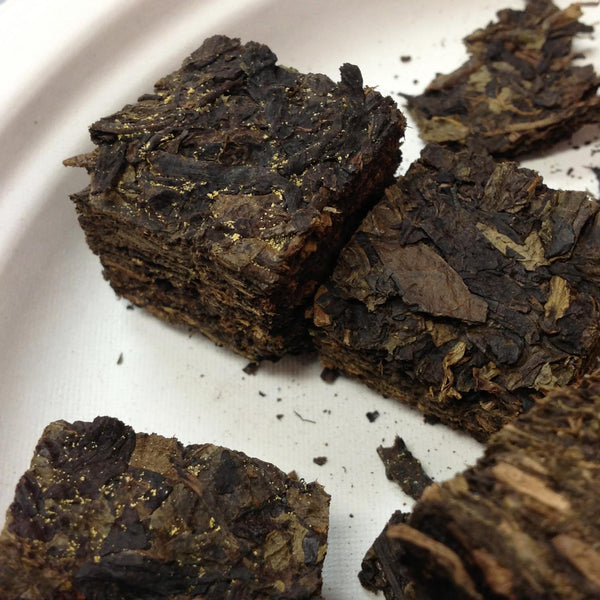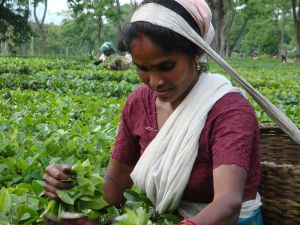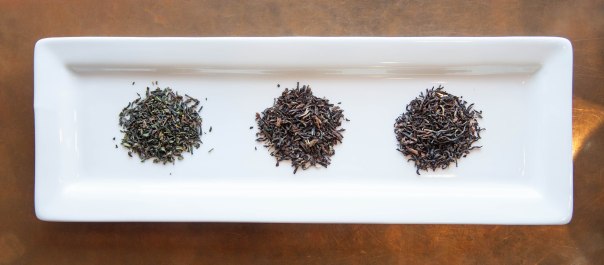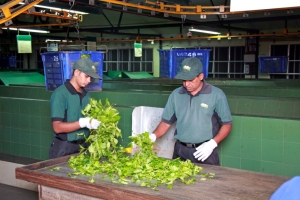-
Darjeelings are the highest elevation produced teas in the world. They are referred to as "The Champagne of Tea". For a tea to be called Darjeeling, it needs to come from the Darjeeling district, state of West Bengal, India. “Darjeeling Tea” is a legally protected geographical designation for teas grown and manufactured in this very specifically defined region “Darjeeling.”
-
Dark tea is unique because it is the only deliberately aged tea that undergoes a secondary fermentation process. Because of this additional step, it contains an active micro-organism called Golden Flowers (Eurotium Cristatum). This micro-organism is present specifically in Dark tea made in Anhua County, Hunan Province, China. Golden Flowers is actually visible in some Dark teas and looks like tiny yellow flecks. If you want to experience Golden Flowers up close and personal, check out our Fu Cha brick.
Puer, which is a sub-category of Dark tea, contains a different micro-organism called Asper Nigellus. This is due to variation in growing conditions, soil, and geography. Golden Flowers is a relatively new discovery, having just been identified in the last 30 years. To this day, the process of making Dark tea is a closely guarded secret. Here are some quick facts about Anhua Dark tea for all you biochemistry buffs out there:- Significant polyphenol content
- Significant L-Theanine content
- Significant thearubigin & theaflavin content
- Significant polysaccharide compounds
Dark tea is a critical source of minerals and nutrients to people in many areas of China. Over the past several years TeaSource has had the opportunity to work with Ms. Zhang Liumei, tea scientist and co-founder of Yiqingyuan Tea company in Hunan Province. Ms. Zhang created one of our most popular and unique teas, Dark Rose, which is pressed into a small heart shape. She describes it as “a spa in a cup” and she’s right. It’s a perfect introduction to this fascinating category of tea.
-
Iced tea is the stuff of summer. Everybody knows that. Sweet tea, tea cocktails, tea infused beer, and even tea with ice cream all come to mind as tasty ways to beat the heat. We have regular customers who drink gallon upon GALLON of iced TeaSource Gold in our stores each week, and personally, I don’t know where I’d be without my daily dose of cold brewed Green Mango. I would be hard pressed to find a drink that tastes as good, is actually good for you, and has stood the test of time as well as iced tea. It's almost as American as baseball and apple pie, don't you think?

There are so many creative ways to enjoy cold tea that it’s hard to choose just one angle. Here are a few of our favorite recipes to give you some ideas for your next family gathering or get together. Summer is too short to sweat the small stuff, so slow down and enjoy it with a cup of iced tea.
-Sarah Cedergren
TeaSource ManagerSpiced Ice Kick
6 cups chilled Montana Gold
3/4 cup orange liqueur or 3 tsp. of orange syrup (Torani or Monin works well)
Mix and serve over ice. Garnish with orange slices.Champagne Oolong
Dry Champagne (or sparkling water)
4 tablespoons of dry oolong tea (we recommend Green Dragon)Steep 4 tablespoons of dry oolong tea in 4 cups of cold water in fridge for 6 hours. Strain, cover, and refrigerate for an hour. Pour half a glass of chilled oolong tea, fill the remainder of the glass with champagne.
Strawberry Arnold Palmer
Take 1 can of frozen lemonade concentrate.
Blend into 1 gallon of cold water.
Cold brew one ounce of Strawberry Oolong in the watered down lemonade overnight. Remove tea leaves.
Serve over ice.
Ohau Iced Tea
8 cups brewed TeaSource Classic Iced Tea (black tea), at room temperature
1 cup cranberry juice cocktail
2/3 cup frozen passion fruit juice concentrate, thawed.Use frozen passion-fruit puree (available at Latino grocery stores), could also substitute passion-fruit juice. 1 cup white cane sugar (if using passion fruit puree only)
Optional: a couple of shots of dark rum. Combine all ingredients, stir, and serve over ice.Click here for easy directions on how to make iced tea.
-
Short History
It is said the Zen priest Eisai (pictured right) brought tea seeds to Kyoto in 1191 and popularized the consumption of powdered tea. It wasn’t until the fifteenth century that a new culture around tea evolved into the modern tea ceremony known as Chanoyu (literally translated “hot water for tea”). The tea ceremony is an extremely structured and studied ritual that embodies many philosophical, artistic, and aesthetic concepts unique to Japanese culture.Uses For Matcha
Traditionally, a powdered green tea called matcha is used during the tea ceremony, along with an array of traditional utensils. Matcha can also be prepared casually and is often used in recipes for ice cream, chocolate, and smoothies. The tea ceremony is just one way to appreciate the act of making and serving matcha, but it is by no means the only way.Production
Matcha is made from the tea leaves similar to those grown to make Gyokuro, a high grade tea that is shaded for the last three weeks before plucking. The shading causes the plant to produce more chlorophyll, giving both the leaf and the liquor a brilliant emerald color. These leaves are then stone ground into a powder to make matcha. High grade matcha steeps up sweet and slightly bitter with a taste of the sea. Japanese teas are distinct for three main reasons: they are machine harvested, they are often shaded before plucking (though not always), and they are steamed instead of fired.How Do I Make Matcha?
It is not difficult to make matcha at home using the traditional utensils. In fact, it affords an opportunity to develop a ritual of your own. You do not have to be a tea master to enjoy preparing matcha.Supplies
Here’s what you’ll need to get started.
-Bamboo tea scoop
-Tea bowl
-Bamboo tea whisk
-Small strainer
-Ceremonial grade matchaDirections
- Heat the tea bowl with a small amount of hot water, the same way you would warm a teapot.
- Using a bamboo scoop, measure two heaping scoops (0.75 grams) into your tea bowl. (NOTE: It is important to sift the matcha through a strainer to remove any clumps.)
- Heat your water to a rolling boil and add a small amount of cold water to bring the temperature down to 175 – 185 degrees.
- Measure approximately ¼ cup of water and pour it into the bowl.
- Whisk the matcha vigorously for 15-20 seconds. Small bubbles will start to appear on the top of the liquid. TIP: The whisking action comes from the wrist; your arm should not move at all. Make “M” or “W” shapes with the whisk, careful not to let it touch the bottom of the bowl. This will fully aerate the tea as it dissolves.
“Yet what is truly amazing is that nothing special or extraordinary takes place. The host and guests simply engage in the act of making and drinking tea. But it is this act that is important, for in the smallness of the tea room, the whole universe – heaven, earth, and life itself – can be evoked.” -Yasushi Inoue
-
India grows a lot of tea. It is the second largest tea producer in the world (China is first) – making over one million metric tons of finished tea per year. But the story told to us about Indian tea is actually much larger than India (and India is big!). It is also about the British empire; it is about the East India Company and the consequences of global trade; and it is about the influence of the west on the east.
Up into the 19th century, tea plants and the tea trade belonged to China. But the demand for tea was rapidly growing in the west and so were the pressures with the East. Because the Chinese had a monopoly on tea and little interest in European goods, they could demand to be paid in silver, causing the British to run significant trade deficits (an issue America and China are grappling with today).
To reverse the flow of silver back home, the British began selling large amounts of cheap opium (grown in India) to China. Furious at the British for turning their country into opium addicts (and depriving them of silver), the Chinese began confiscating and destroying the British opium supplies. The British retaliated with military force and fought what we now refer to as the first "opium war" of 1839-1842.
While these tensions were escalating, the British discovered an indigenous tea plant (camellia sinensis var. Assamica) growing in India. This was of no significance to the rest of the world until a couple employees of the East India Company began a project to start cultivating these wild tea plants in Assam.
Motivated to find a commercial alternative to Chinese tea, the British had already been experimenting with growing tea in India. The lack of experience and infrastructure (Assam was an undeveloped jungle at the time) prevented any real success up to this point, but these Assam tea plants proved well suited for the warmer climates of India. Through the stubborn persistence of the British (none of this came easy and often ended tragically) and help from imported Chinese knowledge and labor, the cultivation of tea in India became viable – and the proliferation of the Assam plant grew it to the size it is today. As the modern Indian tea industry established, three "official" geographically recognized tea producing regions emerged: Assam, Darjeeling, and Nilgiri.
Assam
The home to India’s native tea plant, Assam was a jungle surrounding the Brahmaputra River valley in east India. It currently produces over 50% of India’s total tea output and Assam teas are noted for being strong, full-bodied, with malty flavors. The indigenous Assamica plant prefers the warm, lush environment of its home and can stay productive most of the year, though 2nd flush teas are often considered the best. CTC teas are common in Assam. CTC, or "crush, tear, curl," teas are machine processed versus orthodox manufacturing. But fine orthodox teas are still available and range from their traditional deep, malty cups to sweet, almost tobacco-like flavors, similar to Yunnan teas (which is not surprising since the cultivars are similar and nearby on the map).Darjeeling
This famous tea produced at the foothills of the Himalayas in Northern India is not only unique among Indian teas, but distinguishes itself from teas grown anywhere else in the world. The British started coming to these picturesque mountains for relaxation and recuperation – the high mountain air was considered healthy and cleansing. But the high altitudes, cooler weather, and well-drained soil proved to be perfect for growing tea – particularly the Chinese tea plant, which prefers this climate over the tropical weather of Assam and Nilgiri. Darjeeling teas are known to steep up light, floral, fresh, and sometimes astringent. They also market the significant seasonal contrasts produced between the first and second flushes. (For more, read our blog post "I’m dealing Darjeeling" )Nilgiri (South India)
The teas of the "Blue Mountains" of Southern India are often overshadowed by the Darjeeling and Assam, but no less important to the story of India tea. Because of the tropical environment, Nilgiri plants (primarily the Assamica variety) will flush year round and are not separated by "flushes" like Assam and Darjeeling teas. Known for their smooth, fruity, gentle nature, the best orthodox teas from Nilgiri happen in the winter months of January and February, where sometimes even a little frostbite from the highest elevations can add unique and desirable complexity to the cup.The above is not comprehensive. There are many details to fill in, many exceptions, and still much to learn. As always, the best way to learn is to taste them, and read more.
-Michael Lannier
TeaSource manager -
Tea pluckers in Sri Lanka
Tea from Sri Lanka is immediately identifiable – bright, brisk, quenching, fruity - except for the fact that after gaining independence from the British, Sri Lanka still sells their teas under the old colonial name “Ceylon.” It proves that the idea of “brand management” goes back a lot further than modern management theory, but for the story of Ceylon tea we don’t have to go that far.Up until the late nineteenth century, Ceylon was producing coffee, not tea. But the conversion began in 1869 when a parasitic fungus that attacked the coffee plants started spreading across the island. The former Dutch and now British occupiers had been experimenting with tea plants they brought to the island and the coffee blight prompted them to convert land to commercial tea production in place of coffee. British demand was so high for these new teas that by 1900 there were over 300,000 acres of tea planted on the tiny island.
Ceylon teas are noted for their “fruity” and brisk flavors, though this is not why you will often see the words “Orange Pekoe” on a package of Ceylon tea (the name has nothing to do with oranges – even more curious is that no one exactly knows how it got the name “Orange Pekoe”, though there are theories). Orange Pekoe or “OP” is in reference to the leaf grading system used in Ceylon teas (and other countries). In the most simple of definitions (and therefore not without inaccuracies) OP is the longer, whole leaf grade, and BOP – or “Broken Orange Pekoe” - is the broken or smaller leaf grade.We could get very long-winded and annoyingly academic if we wanted to start listing all the nuances and exceptions within that definition, but it’s more important to note that the grading system is not necessarily a judgment on quality, but rather a categorization of size and appearance.
Though it is tiny in size (approximately the size of West Virginia), Sri Lanka is the fourth largest tea producer in the world, at over 325,000 metric tons per year. Part of this is attributable to its warm, lush, tropical environment that prevents the bushes from going into dormancy. This allows the plants to be picked year round, with some areas experiencing fairly dramatic seasonal variation. Because of the year-round growth, Ceylon teas are not grouped into 1st or 2nd flushes like Indian teas nor have anything similar to the spring tea distinction in China. However, the plants are rested periodically by heavily pruning them back to maintain quality and longevity (the plants can stay productive for approximately 40 years, give or take depending on the region).
Quality control during the withering process.Though its tea history is relatively short, Sri Lanka is always singled out for its commitment to quality. In the 90’s and early 2000’s, Africa and even a significant portion of India focused on producing more tea instead of great tea. Sri Lanka resisted this trend. Ceylon black teas are consistently some of the finest in world and deserve the attention of anyone with even a casual interest tea.
Beautiful map of Southern India and the island of Sri Lanka, still labeled as “Ceylon."

















